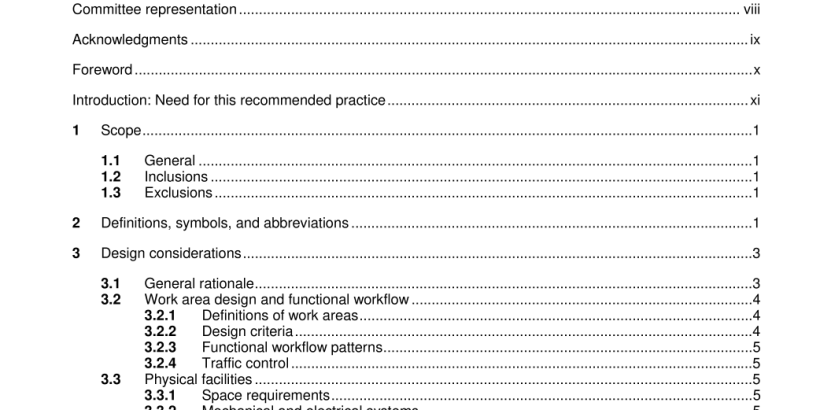ANSI AAMI ST40-2004 pdf download
ANSI AAMI ST40-2004 pdf download.Table-top dry heat (heated air) sterilization and sterility assurance in health care facilities
3.2.3 Functional workflow patterns
Workplace design should allow adequate space for all functions and should promote efficiency by minimizing distances between related areas. Functional work areas should be physically separated by walls, partitions, or space to maintain good traffic flow and to contain contaminants generated during the phases of reprocessing. Workflow patterns should be designed to flow from soiled areas to clean areas. Malkin (2002) and Runnells (1 987) provide examples of work area design and workflow patterns. Rationale: Separating clean and “dirty” areas limits environmental contamination and, therefore, the bioburden on items to be sterilized.
3.2.4 Traffic control
Traffic in all areas in which decontamination, preparation and packaging, sterilization processing, sterile storage, and distribution are carried out should be restricted to authorized personnel. Criteria for authorized entry, movement within processing areas, and attire should be specified in written policies and procedures. It is sometimes necessary for visitors to enter restricted areas; visitors should comply with the established dress code, as stated in the policies and procedures. (See also 4.5.) The responsibility and authority for enforcing traffic control policies and procedures should be specified, as should methods of compliance. Rationale: Good traffic control practices protect personnel, patients, and medical devices from potential sources of cross-contamination.
3.3.1 Space requirements
The needs of each health care facility should determine the sizes of processing areas. Considerations are the operational systems, equipment, and workload expected of each functional work area. Space should be provided in proportion to the volume of work anticipated and the amount of product that will be routinely stored. The degree of mechanization, the product mix (e.g., reusables vs. disposables), and the storage and distribution methods used may affect space requirements and may change over time. Walls or partitions should separate functional work areas to control traffic flow and contain contaminants generated during processing. Rationale: Space requirements may vary significantly, depending on the specific activities and processing needs of the health care facility. In general, the space needed to perform routine maintenance activities, such as the reprocessing of reusable medical devices and supplies, tends to be underestimated during the planning phase.
3.3.2 Mechanical and electrical systems
In addition to the routine plumbing systems, the processing facility may need pressurized systems such as compressed air (high- or low-pressure, or both) and nitrogen. A source of distilled or demineralized water may also be needed. Electrical systems should be designed to allow for the safe and effective operation of the equipment (e.g., cleaning, sterilization, computers, telephone, lighting) used throughout the facility/department. The emergency power service of the facility should be extended to include sterilization processing equipment. The electrical engineers involved in the design process should be aware of the work of the sterilization department and collaborate with the operations manager of the department. For some equipment, uninterruptible power sources are recommended. An adequate number of suitable electrical outlets and ground fault interruptor outlets and adaptors should be provided. Rationale: Because of the increased sophistication of today’s medical technology, complex equipment and systems may be needed to inspect, maintain, or verify equipment and device performance and to ensure the safety of employees. The complexity of processing and sterilization technologies, as well as patient and employee safety, requires adequate, safe, and reliable electrical service.
Rationale: Ventilation patterns affect the proliferation and spread of potentially pathogenic microorganisms. Control of environmental contaminants and product bioburden is essential to ensure the effectiveness of the sterilization process. The recommended air flow pattern (i.e., air flowing out of clean areas into “dirty” areas) ensures that contaminants are contained within the decontamination area and minimizes the possibility of air currents carrying contaminants from the decontamination area to clean areas. The recommended number of air exchanges per hour reflects the committee’s consensus on the minimum air exchange rate necessary to effectively reduce environmental contamination by air dilution. Down-draft type air circulation systems limit contamination by carrying contaminants toward the floor and away from work surfaces. Portable fans should not be used because they create highly turbulent air flow, which recirculates dust and microorganisms from the floor and work surfaces and thus interferes with designed air flow characteristics.
